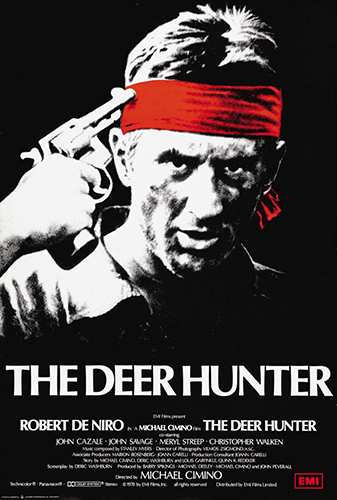The Deer Hunter
- 30 May 2016
- The 1979 Oscar winner for Best Picture is epic and, surprisingly, understated.

Michael Cimino is the quintessential one-hit wonder, but his one hit is some wonder. I finally saw The Deer Hunter last summer, and for the most part, I was impressed. Today is better than any other day—except the 11th of November—to write about this movie, especially following the recent presidential visit to Vietnam, where the middle act and the climactic scenes place.
Robert De Niro’s Mike is cool. He is the classic alpha-male among his pack of friends, who include Christopher Walken’s Nick and John Savage’s Steven. The most unforgettable moments are Mike deciding to triple the ante of the Russian Roulette in the riverside camp and Mike later hugging a reclusive Steven in the hospital. This performance is the best that I’ve seen by De Niro, though I haven’t watched Taxi Driver.
The infamous Russian Roulette scenes don’t impact me, however. I understand why these scenes are groundbreaking for their time, but the visual and sound effects are dated. Worse, the men who portray the guards in the riverside camp are obviously not Vietnamese. Besides not looking the part, their constant barking of “Faster!” and “Quiet!” in Vietnamese—though appropriately irritating—is almost certainly done because of the actors’ limited Vietnamese.
I don’t mind the portrayal of Russian Roulette as a form of war-time sadism and, later in the movie, post-war trauma. It might not be historically accurate, but it’s cynically plausible. I’ve read Bloods by Wallace Terry about four times. I believe the first-hand accounts that are in the book, and they’re worse. Considering the loose Soviet-Vietnamese relationship of the era, I can image the North Vietnamese adopting Russian Roulette.
The visuals are worth mentioning. The deer-hunting scenes are mesmerizing because of the landscape; I like the shot of the aquamarine river the best. The movie’s acclaimed cinematographer, Vilmos Zsigmond, died earlier this year. His only hiccup in The Deer Hunter is the archival footage that shows chaos outside the US embassy before the fall of Saigon. These shots are jarring because they look so different from the rest of the movie.
Nonetheless, The Deer Hunter has had lasting influence. Both The Simpsons and Archer have paid homage. Jarhead has its characters watch the opening titles. Call of Duty: Black Ops has a similar Russian Roulette sequence. Depictions of Solid Snake in Metal Gear Solid and Big Boss in Metal Gear Solid 3 resemble the looks of Walken and De Niro, respectively, at certain points of the movie. Not surpisingly, it’s been honored in the National Film Registry.
The more I read about Michael Cimino, the more admire him. He hasn’t had success in Hollywood since the 1978 release of The Deer Hunter, and he’s approaching his 80s, so a triumphant comeback is unlikely. Even with a movie-carrying De Niro, an Oscar-winning Walken, a young Meryl Streep, and a dying John Cazale, the best aspect of the movie is its ending. It’s not supposed to be a condemnation of war or even a celebration of surviving.
It’s just a group of people who trying to cope with the death of their friend, in a way that real people have done and will do.